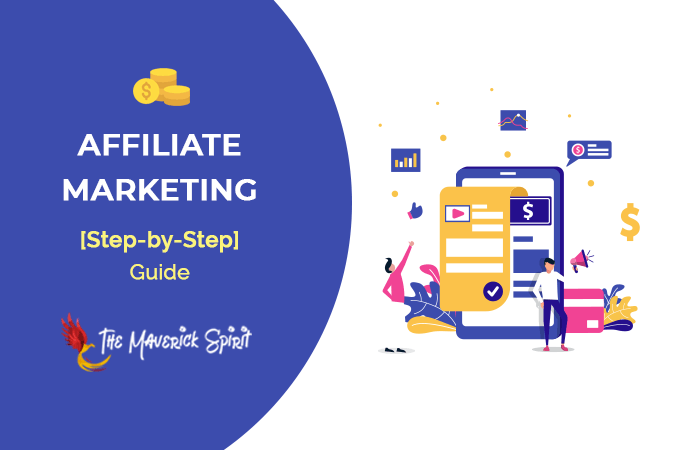Affiliate Marketing Guide – What is & How Does it Work?
Every individual, working or non-working, searches for ways to earn passive income at least once. In other words, ‘How to make money online?’
One of the popular answers to the above question is Affiliate Marketing.
You can earn a million dollars from Affiliate Marketing. That means Affiliate Marketing has the potential to be your primary income source rather than passive income.
However, you have to be familiar with certain terminologies and strategies to earn a good amount of money via Affiliate Marketing.
You’ll truly earn a fortune but it takes time, discipline, and consistency of efforts.
In this article, you will learn everything to start with Affiliate Marketing and to become a successful affiliate marketer by doing things right and consistently.
Table of Contents
Getting Started With Affiliate Marketing
You must already be familiar with the idea of Affiliate Marketing but you aren’t sure where to start.
To help you understand the whole process, let’s proceed step by step.
What is Affiliate Marketing?

Affiliate Marketing is earning a commission by promoting a company’s or merchant’s products to the customers. Affiliate marketers earn a percentage of revenue based on every sale they make or a lead they generate for the merchant’s company.
For example, if you promote a product on your affiliate website, Facebook, or YouTube channel, you get a commission if your audience ends up purchasing the product through your referral link or ad.
How Does Affiliate Marketing Works? [5 ROLES]
Affiliate Marketing consists of five major pillars listed below.
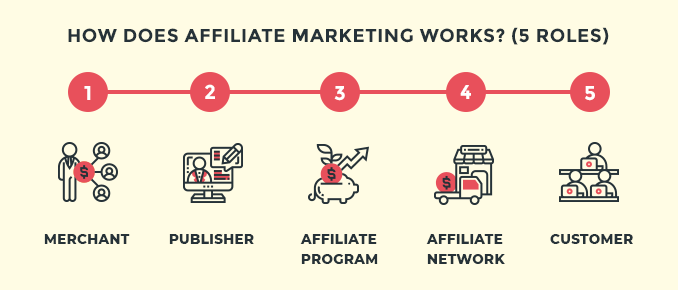
1. Merchant
All the retailers, product creators, sellers, companies fall under Merchant tag. Merchants own the products or a service that they want to make available for people to purchase.
A merchant could be a person or a large enterprise.
2. Publisher or Affiliate
This is where you work. A publisher or an affiliate is an individual or organisation that promotes an advertiser’s product or service in exchange for commissions.
After signing up for a ‘Partner Program’ or ‘Affiliate Program’ with the merchant via the affiliate network, you get a special referral link.
Once you start promoting a product via a referral link on your blog or vlog channel, the process starts.
If your audience actually ends up buying the product through the link, congratulations, you get a small percentage of every sale you make.
3. Partner Program or Affiliate Program
Partner or affiliate program are also know as associate program that a product or service website offers.
These programs provide methods in which a merchant pays affiliate commission to affiliate websites when they send traffic or leads to them.
These programs do have certain agreements, resources, tracking tools, and creatives that a publisher or affiliate can make use of.
4. Affiliate Network
The affiliate network interlinks the merchant with the publisher or an affiliate.
The network handles all the audience tracking, conversions, payments, and more.
The very famous examples of Affiliate Networks are –
5. Customer
Customer or an audience is an important entity of affiliate marketing. They trust your recommendations and buy a product, which helps you earn money.
Your focus should be on your audience. Based on your audience, you can design your marketing campaigns.
The above five phases sort of follow a waterfall model where each affiliate sale starts with a merchant and ends at the customer.
How to Get Started with Affiliate Marketing?
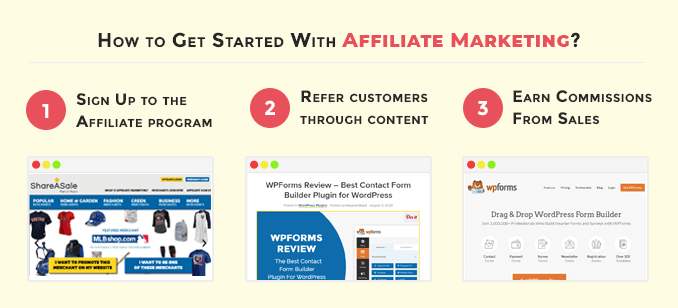
The primary step is to sign up for an affiliate program. But you cannot do that out of the blue. You should have a niche and a platform to get started.
To understand the process, let’s consider the Amazon Associates Affiliate Program.
At the footer section of the Amazon website, you will find a category named ‘Make Money With Us’. Out of all the options, you need to select ‘Become an Affiliate.’
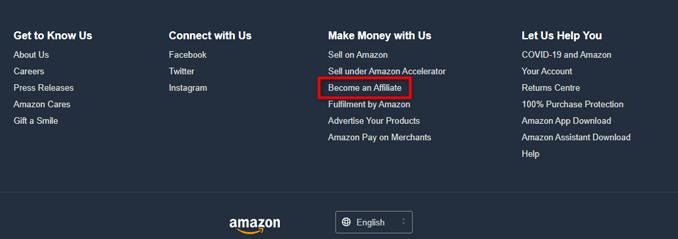
Technically it’s only a matter of three steps: Sign up, Recommend / Refer, Earn Commission / Make Money.
But what would you recommend and on which platform?
Let’s answer this question to get started with Affiliate Marketing.
1. Deciding the Niche
Maximum affiliate marketers choose a niche or area of specialization. You don’t have to be an expert in any niche, but you must be interested in or enthusiastic enough to work in any new niche.
Here is an article that will help you on – How to Choose a Profitable Blog Niche for Your Blog? [4 Steps to Follow]
When you have a good knowledge of something, say gadgets, you tend to put genuine reviews and recommendations. This is the key to gain audience trust.
For example,
- If you are a Tech Vlogger, you can start recommending vlogging cameras, microphones, laptops, or electronic devices that you use for video editing.
- For a fashion influencer, recommending beauty products would be more relevant. Likewise, you can decide a niche to get started with.
Once your audience starts trusting your recommendations, you can also share other products like a smartphone you purchased recently from amazon. Or books that changed your life.
2. Choose Products & Services and Sign Up to The Affiliate Program
Once your niche is decided, it’s time to find out products and services that you want to promote in order to make commissions.
Locate their affiliate or partner program, sign up and get the unique referral link to promote services.
After setting up your affiliate account and bank account to receive a commission, you will be ready to start recommending the products.
The majority of the affiliate networks share their own –
- banners,
- short referral links,
- creatives,
- and ads with you so that you can easily embed it on your platform.
Nowadays, a lot of digital services, online companies have their Partner Programs. You can partner with more than one company by signing up for their associate programs.
3. How Can You Promote Products and Services?
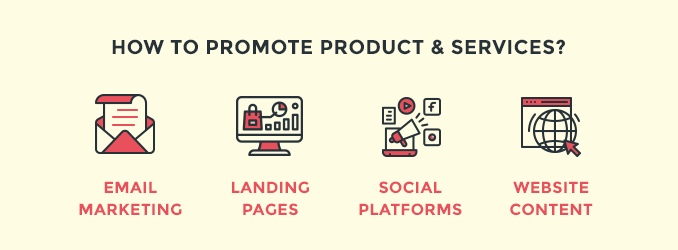
You can promote affiliate marketing services and products through various mediums like –
- Affiliate Websites
- Landing Pages
- Email Newsletters [Affordable Email Marketing Services]
- Social Media Platforms
Amazon will ask you to put a URL to a platform that you are going to use for product recommendations.
You can use free platforms such as social media, or you can set up a blog by purchasing a domain for blogging and affiliate marketing.
Many people start with a Facebook page, Instagram page, or YouTube channel. After gaining more audience and making a considerable sale, you can buy a domain website as well.
How Do Affiliate Marketers Get Paid?
Coming to the point, Affiliate marketers gets paid based on three things –
1. Pay Per Sale
You will receive a small percentage price of every sale you make via your referral link. Pay Per Sale is applicable after the user completes the purchase.
The amount is usually applied to the whole cart. For example, you have put a referral link on a vlogging camera.
If the user ends up buying lenses and a tripod stand along with the camera, then you get a commission for the whole cart. This might vary based on the business terms of the merchant.
2. Pay Per Click
In this method, you get paid based on the traffic you drive to the merchant’s website.
Irrespective of the sale, the merchant will pay you a specific percentage of an amount based on the number of users redirected from your affiliate platform to the seller’s platform.
The amount you earn per click could be less than the amount per sale. However, the more people click on the ad or a referral link, the more money you will earn.
3. Pay Per Lead
In this program, the merchant/seller will pay you a commission for every lead you generate for them from your affiliate.
This happens when the user visits the merchant’s website from your referral link and ends up signing up for a mailing list or filling up the contact form.
The more traffic you have on your platform, the more money you will earn via affiliate programs.
The merchant can identify the traffic coming from your site to theirs by your unique Affiliate ID.
Apart from the three terms used above, affiliate marketers can earn money from various other ways.
To learn more such ways, let’s understand some common Affiliate Marketing terminologies.
Affiliate Marketing Terminologies
From the previous points, you have come across some Affiliate Marketing terminologies such as Merchant, Publisher, Affiliate network, and pay per sale, click and lead.
There are some common Affiliate Marketing terminologies that you must know.
1. Affiliate Creatives
Affiliate creatives are the resources of materials used by advertisers/publishers to promote a product or a service of a merchant. For example, text links, banners, ads, or videos.
2. Deep Linking
Deep-link or direct links take a user to the destined product page instead of a home page or a domain page.
For example, rather than using amazon.com, you can share a deep link such as amazon.com/electronics/smartphones.
In the case of mobile phones, deep links check if the user has the required app installed on the phone and takes the user directly to the destined page on the app.
3. Referral Program
Referral program gives a specific commission or a bonus payout to the affiliates who brought new affiliates to sign up the partner program of a company.
4. Conversion Rate (CR)
The conversion rate indicates how many users who clicked your referral link actually purchased the product.
For example, the conversion rate would be 10% if 100 people out of 1000 who clicked the link end up buying the product via your referral.
5. Click-Through Rate (CTR)
The click-through rate is a ratio indicating how many people who saw the ad (impressions) on your platform actually clicked on it.
The rate also tells how frequently users click on the ads. For example, your CTR would be 5% if 5 users click on the ad out of 100 people who saw the ad.
6. Cost Per Action (CPA)
The merchant pays a commission to the affiliate/publisher if the user completes certain actions using the publisher’s referral.
The action could be signing up for a new service, filling a contact form, using a certain offer, etc. The commission amount will be based on each action taken by your promotional resources.
7. Cost Per Order (CPO)
Cost per order is the amount or a share you get for every sale you make or every lead you generate via your promotional platform.
8. Cost Per Mile(CPM) or Cost Per Thousand(CPT)
CPM or CPT represents the amount an affiliate marketer will receive for every thousand impressions on a promotional ad.
It can be calculated by a simple formula.
CPM= cost of advertising/number of impressions x 1000.
9. Earnings Per Click (EPC)
EPC is the same as pay per click, which indicates the amount of money a publisher will earn for every click on the promotional link or ad.
10. Return On Investment (ROI)
ROI is a percentage or a ratio of a profit you made for the amount invested in the promotional campaign.
ROI= (Gross profit – Invested amount)/invested amount *100.
So, if you invest $100 in a promotional campaign and earn a gross profit of $250.
ROI would be (250-100)/100*100 = $150.
11. Advertiser
Advertisers are the brands or businesses that partner with the affiliate to drive traffic on the merchant’s website.
12. Cookies
Cookies are the special files stored in the customer’s computer to identify them as the audience of an affiliate marketer.
These cookies have an expiration date set by the merchants or businesses. When a user clicks on the affiliate link, the cookie file gets stored in the user’s computer and the timer starts.
An affiliate marker gets the commission if the user ends up purchasing the product before the cookie expiration period.
13. Tracking Pixel
A tracking pixel is a small HTML image code placed on the web page by an advertiser to track users.
It’s an invisible image that gets loaded with the webpage. The image helps the marketer track the number of impressions, clicks, and sales made by the user.
14. Tracking Link
The tracking link has a specific code embedded in the URL to track the website visitors and potential leads for marketing campaigns.
15. Payment Threshold
The payment threshold indicates the amount of commission funds you have to gather via the affiliate program before withdrawing it.
It depends on the partner program terms. Let’s say if the threshold is $100 for a certain affiliate program, you can only withdraw the money after reaching or crossing $100 funds.
16. Landing Page
Companies or Merchants assign a landing page URL to their affiliates.
Instead of a referral link, publishers can put the landing page URL in the promotional ads which take users to the desired web page of the company’s website.
17. Payout
Payout is the amount of money decided by the advertiser, which indicates the revenue received for each conversion. The payout amount could be fixed or dynamic.
18. Banner Ads or Affiliate Marketing Banners
Companies that use banner affiliate programs provide readymade banner ads to their affiliate markets to easily embed in the promotional platform.
19. Segments in Affiliate Marketing
Creating segments in your affiliate marketing is nothing but dividing your marketing methods to apply different marketing strategies.
Segments are helpful as every marketing method will target different audiences and will require different strategies.
Conclusion – Why Be an Affiliate Marketer?
Now you have an idea of the basics of Affiliate marketing and how to get started with it.
Affiliate Marketing, over the period, can give you amazing returns on your promotions.
Even though many people consider it as a passive income, affiliate marketing can become your full-time income source.
There are a lot of benefits to entering the world of Affiliate Marketing.
1. Zero investment cost
You don’t need to invest any money to get started with affiliate marketing.
All you need is a platform, next sign up for an affiliate program for free and start promoting products on your social media accounts or affiliate websites.
2. You get to do what you like
You get the freedom to recommend and review products you love to convey to others and use your own strategies to earn commissions.
3. Financial independence
You don’t have to have a professional degree to become an affiliate marketer. Your passion for the niche would be strong enough to give you financial stability.
The growth of your business is in your hands. The more audience base you gain, the more money you will be able to earn.
4. Scale your business
You can grow your marketing business into a big company. Starting with a free platform and gradually learning the strategies to turn the small thing into a big picture is not hard.
You can hire more people, create more platforms, and turn the whole thing into a business.
Earning a piece of the pie from promotions would be the outcome of your amazing marketing strategies.
